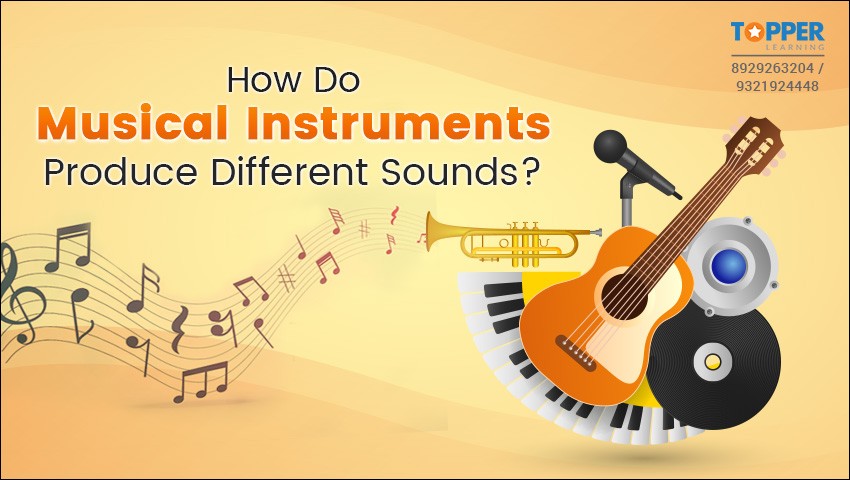How Do Musical Instruments Produce Different Sounds?

In this blog, we have tried to understand what is sound. Its characteristics such as pitch, quality, loudness, etc. Also, we will discuss the working principles of various musical instruments and the science behind the production of music.
By Topperlearning Expert 16th Jan, 2024 | 01:05 am
ShareIntroduction
I am sure all of us love hearing music and we all have a particular taste in it. But have you ever wondered about the science behind these delightful sounds? And what make them so distinguish from one another? In this blog, we will explore the science behind this and explore the understand why each set of instruments produces its unique sound signature.
What is sound?
To understand how each music instrument where able to produce distinguish sound, we must first understand what sound is. Sound is a form of energy which travels in a form of wave and produced due to vibrations. These vibrations travel through a medium, usually air, and reach our ears, creating the sensation of hearing.
A sound wave can be considered the propagation of pressure or density variations in the medium, i.e., it propagates in a medium as a series of compressions and rarefactions. A region of compressed air (increased density or pressure) is called a compression (C) and that of rarefied air (decreased density or pressure) is called a rarefaction (R). A vibrating object produces a series of compressions and rarefactions in the medium. Hence the material medium is necessary for the propagation of sound, and it can be solid, liquid or gas.
Example: When the prongs of a tuning fork move forward, compression is formed, and when the prongs move backwards, rarefaction is formed. As sound propagates, it is the sound energy which travels in the medium and not the particles of the medium.
Sound waves are longitudinal waves as the particles of the medium through which the wave propagates vibrate in a direction parallel to the direction of propagation of waves. This pattern forms a sinusoidal wave, which defines the characteristics of sound.
Characteristics of Sound
Sounds can be distinguished from each other by three characteristics—loudness (intensity), pitch (frequency) and quality (timbre).
- The intensity of sound at any point is the amount of sound energy passing per unit time per unit area in a direction perpendicular to the area. Its unit is watt/metre2 (W/m2).
- The physiological response of the ear to the intensity of sound is called loudness. It is determined by the amplitude (A) of the wave.
- Pitch is the physiological sensation which helps in distinguishing a shrill sound from a flat sound. It is determined by the frequency (ν) of the wave.
- Quality (timbre) distinguishes one sound from another sound of the same pitch and loudness. It is determined by the wave form of the sound.
- A sound of single frequency is called a tone. The sound produced by a mixture of several frequencies is called a note.
How Instruments Produce Sound?
Musical instruments are an amazing device which converts one form of energy to another. It can be classified based on the primary mechanism through which they produce sound.
Here are four main types of music instruments string, percussion, wind and reed instruments.
- How do string instruments produce sound? Instruments which produce sound due to vibration of strings are termed as stringed instruments.Following are some of the example of string instruments.Violin, Viola, Cello, Guitar (Acoustic and Electric), Harp, Mandolin, Banjo, Sitar, etc.
- How do percussion instruments produce sound? Instruments which can be produce sound due to vibration of stretched membrane by being struck, hit or rubbed are termed as percussion instruments.
Example of such instruments are drum, tabla, dholak, etc. - How do wind instruments produce sound? The instrument which produces sound when air is blown into a resonator. Wind instruments, including flutes, trumpets, and clarinets, rely on the vibration of an air column.
Musicians create sound by blowing air into the instrument, causing the air column to vibrate and produce specific pitches and tones. - How do reed instruments produce sound? Reed instruments, like the saxophone or oboe, utilize a thin piece of material called a reed. When the musician blows air over or through the reed, it vibrates, setting the air column into motion and creating unique sounds.
The uniqueness of each instrument's sound can be attributed to various factors. The material of construction, shape, and size all contribute to the distinctiveness of their tones. Additionally, the method of sound production, whether through plucking, blowing, or striking, adds layers to the musical tapestry.
Have you ever wondered why every person has a unique voice?
When we speak or sing, the vibrations we feel in our throat are the result of the vocal cords in our voice box, scientifically known as the larynx. Positioned at the upper end of the windpipe, the larynx houses two vocal cords that vibrate when air passes through, creating the unique sound of our voice.
Most ask questions.
Check out some of the most ask questions on our topper learning ask a doubt platform.
Q 2. State three characteristics of a musical sound.
Q 3. What are musical instruments? What are their main types?
Conclusion:
We hope you enjoyed reading this blog and learned something new about musical instruments and science behind it. The topic sound is not only crucial as per the CBSE class 10 syllabus but it’s important for building a solid foundation. We believe that in this day and age, kids must know about solving real-world problems, understand technology better, and spark creativity and innovation.
At Topperlearning, we want to help kids prepare for these opportunities by teaching them about concepts and how to apply them in real life according to the NEP 2020 plan.
Learn more about such topics with TopperLearning to spark curiosity among the kids. We bring you high-quality study materials like video lessons, sample papers, practice questions, textbook solutions, concise physics class 10 revision notes and more for CBSE, ICSE, Maharashtra Board, JEE and NEET to help you take your exam prep to the next level!
TopperLearning is now on WhatsApp Channels!
Click the link below to subscribe today and stay updated on current affairs, study tips, our latest offerings and more. Click here!
More from Education
Important Resources
- Education Franchisee opportunity
- NCERT Solution
- CBSE Class 9 Mathematics
- NCERT Solutions for class 10 Science
- Sample Papers
- CBSE Class 9 Science
- NCERT Solutions for class 10 Maths
- Revision Notes
- CBSE Class 10 Hindi
- CBSE Class 10 English
- CBSE Class 10 English
- CBSE Class 10 Social Studies
- CBSE Class 10 Science
- CBSE Class 10 Mathematics
- Career In Science After 10
- Career In Commerce After 10
- Career In Humanities/Arts After 10
- NCERT Solutions for Class 10
- NCERT Solutions for Class 11
- Business Studies Class 12 CBSE project





